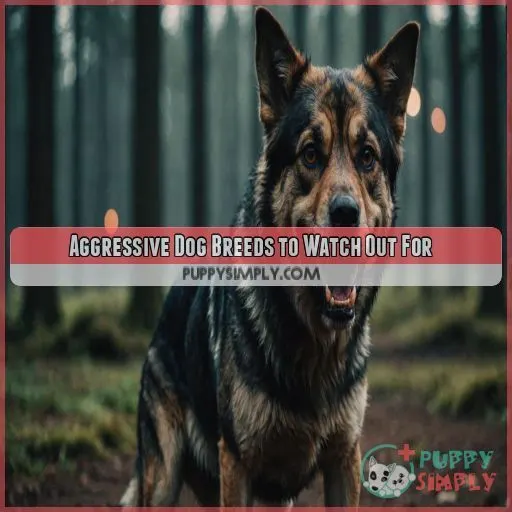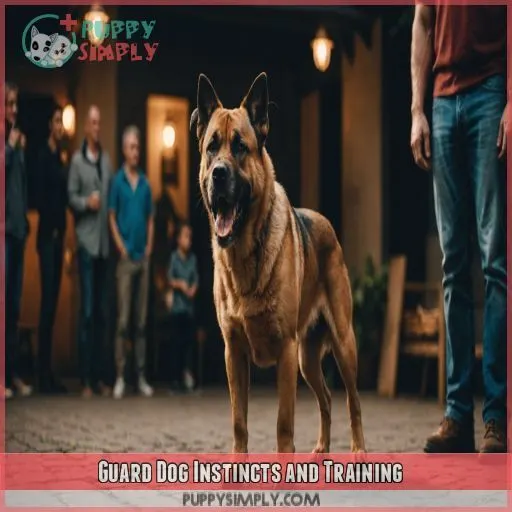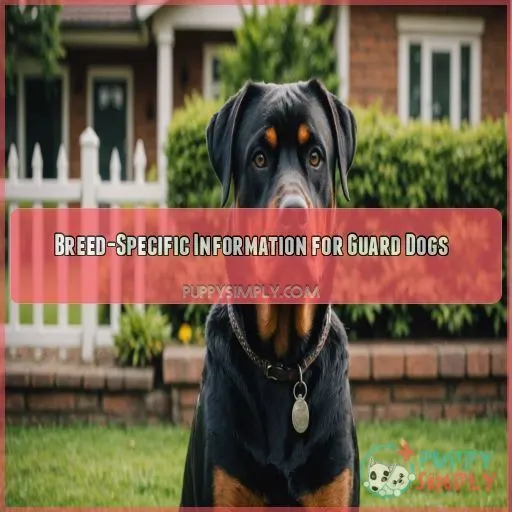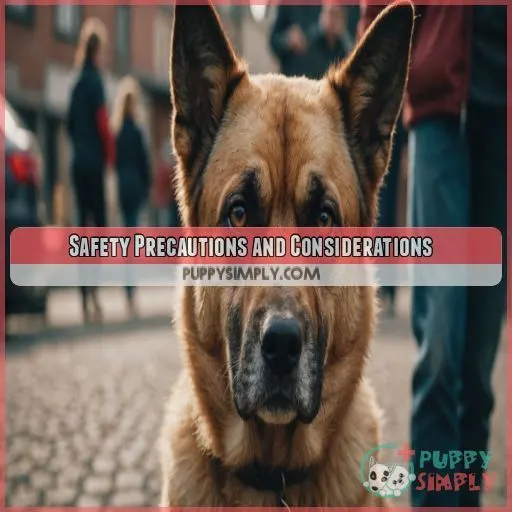This site is supported by our readers. We may earn a commission, at no cost to you, if you purchase through links.
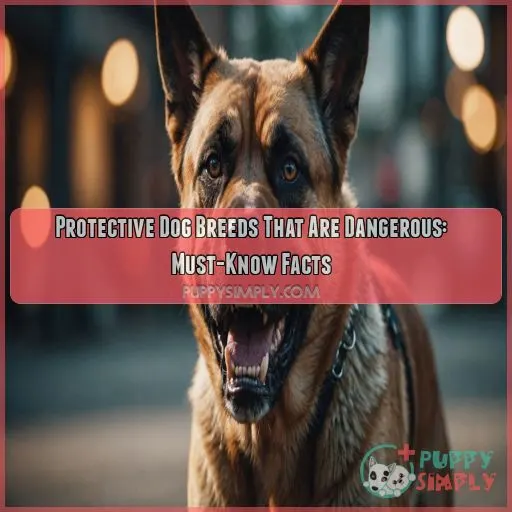
Breeds like Pit Bulls, Rottweilers, and Doberman Pinschers pack a punch with their protective instincts, but what really keeps you safe is proper training and socialization.
Untrained dogs are like misfiring engines—they can get out of hand quickly.
Male dogs, especially unneutered ones, tend to be more reactive.
Want more tips on taming these canines? Keep reading!
Table Of Contents
- Key Takeaways
- Aggressive Dog Breeds to Watch Out For
- Factors Contributing to Dog Bites
- Guard Dog Instincts and Training
- Breed-Specific Information for Guard Dogs
- Safety Precautions and Considerations
- Frequently Asked Questions (FAQs)
- What is the most aggressive guard dog?
- What is the #1 most aggressive dog?
- What dogs are on the dangerous dog list?
- What is the easiest guard dog to train?
- What differentiates protection and aggression in dog breeds?
- How do dog bites impact insurance policies?
- Are dog trainers certification programs effective?
- Which dog breeds require the most socialization?
- What are legal aspects of owning protective breeds?
- Conclusion
Key Takeaways
- You’ll need to be a skilled "dog driver" with these powerful pups. Just like handling a sports car, owning protective breeds requires caution, proper training, and socialization to keep everyone safe. Think of it as teaching your furry Ferrari to play nice at the dog park.
- Don’t judge a book by its cover – or a dog by its breed. While some breeds, like Pit Bulls and Rottweilers, have a reputation for aggression, it’s really about how you raise and train them. With the right care, even the toughest-looking pooch can be a gentle giant.
- You’ve got to be the pack leader, not just a cheerleader. Consistent training, early socialization, and understanding canine body language are your tickets to success. It’s like being a dog whisperer – minus the fancy TV show.
- Know the rules of the game before you play. Research local laws, consider your living situation, and be honest about your experience level. Owning a protective breed is a big responsibility – kind of like adopting a furry superhero who needs your guidance to use their powers for good.
Aggressive Dog Breeds to Watch Out For
If you’re thinking about getting a protective dog breed, it’s important to know which ones might give the mailman or you a run for your money! From Pit Bulls to Doberman Pinschers, these breeds have strong instincts that can make them both loyal companions and potential troublemakers if not properly trained.
Pit Bulls
Pit bulls often wear a misunderstood villain’s cape among protective dog breeds. Their temperament isn’t all drama; with responsible ownership, they’re as gentle as a summer breeze. Legal issues and media portrayal can paint these pups unfairly as aggressive, overshadowing their history as loyal companions. Remember, any dog, pit bull or not, can bite!
Rottweilers
(Source) Rottweilers are known for their loyalty, strength, and natural guarding instincts. While they can make excellent companions with proper training, their size and protective nature require experienced owners who can provide consistent socialization. Responsible Rottweiler ownership involves understanding their unique needs and potential risks to make sure they become well-balanced, trustworthy dogs.
German Shepherds
German Shepherds, known for their intelligence, are like Ferraris: powerful but needing guidance.
They require consistent training to harness their potential.
Socialization and health care are also crucial for a well-rounded, protective companion.
American Bulldog
If you’re fascinated by German Shepherds, hold your horses, because American Bulldogs also deserve attention! These rugged, muscular dogs won’t hesitate to stand by their family’s side.
- Known for confidence and loyalty
- Can be stubborn without training
- Proper socialization is key
- Regular exercise maintains good health
- Historically used for farm work and protection
Don’t let their size fool you; they’re real sweethearts!
Bullmastiff
Have you ever met a Bullmastiff?
With their fearless presence, these gentle giants might seem intimidating.
Known for their protective nature, they’re incredibly loyal and loving with proper training.
Don’t let their size fool you; a Bullmastiff’s temperament demands experienced handling.
Early socialization and training are absolutely essential.
Make sure you’re up to the challenge of owning this magnificent breed!
Chow Chows
Chow Chows, with their fluffy coats and cuddly appearance, may seem like gentle giants, but don’t be fooled. These pups pack a punch in terms of aggression. Here are 4 key things to know about Chow Chows:
- Territorial and Protective
- Wary of Strangers
- Require Extensive Training
- Potential for Unpredictable Behavior
Akitas
After exploring the unpredictable nature of Chow Chows, let’s chat about Akitas.
With roots in Japan, these muscular dogs are as loyal as they are independent.
If you’re an Akita parent, brace yourself for a headstrong companion!
Proper Akita training is essential from day one.
They’re protective, often mistaken for Japanese Tosas, but their strong-willed temperament needs firm guidance for dog safety.
Presa Canarios
You’ve heard about Akitas, now meet Presa Canarios. These muscular giants boast a history from Spain’s Canary Islands, primarily bred as working dogs. Not the easiest to train, their protective instincts can be challenging. A Presa Canario’s temperament requires firm ownership and socialization. Think twice if you’re a first-time dog owner—this breed demands confidence and commitment.
Japanese Tosas
Considering Japanese Tosa ownership? These dogs have a distinguished history, originally bred for wrestling in Japan. Known for their calm yet dominant Tosa temperament, they’re not the breed for everyone. Tosa regulations can be strict given their potential power. Training them is like handling a tiger: respect is key. Consult a personal injury attorney for legal guidance if needed.
Alaskan Malamutes
Alaskan Malamutes are a force to be reckoned with – these fluffy giants pack a punch! While their wolf-like appearance is undeniably striking, their strong-willed nature and high prey drive can make them a handful for inexperienced owners. Proper training, socialization, and plenty of exercise are a must to keep these adventurous pups in check.
Doberman Pinschers
Doberman Pinschers are like the bodyguards of the canine world. Don’t let their sleek looks fool you; their temperament demands consistent training and socialization. With roots steeped in history as protectors, Dobermans thrive with responsible owners who understand their needs. Keep them healthy with regular grooming, and they’ll guard your home like a loyal knight in shining armor.
Boxers
Boxers are loyal companions, but their lively temperament can lead to surprises. It’s like juggling firecrackers, so steady the reins with training and care. Here’s how to keep control:
- Training: Start early—obedience shapes their energy.
- Health: Regular vet check-ups prevent issues.
- History: Understand their playful roots for better bonding.
Respect their boundaries for safe, happy times.
Factors Contributing to Dog Bites
Regarding dog bites, understanding the factors that contribute to them can really make a difference in how you approach safety. Whether it’s the bounded energy of unneutered pets or the usual "keep out" vibes from fence-happy pooches, knowing what makes dogs tick helps keep playtime fun and worry-free!
Male Dogs Vs Female Dogs
When it comes to dog bites, male pups are more likely to be the culprits. Their testosterone-fueled aggression can make them more territorial and prone to lashing out. On the flip side, female dogs tend to be gentler and less reactive. But don’t let gender stereotypes fool you – proper training is key for all canines.
Unneutered/Unspayed Dogs
When comparing male and female dogs, you might notice hormonal impact plays a big role. Unneutered dogs often showcase territorial behavior, acting as if they’re on a never-ending warpath with some invisible enemy. We can’t pin all aggression triggers on hormones, though. Here are spaying/neutering benefits:
- Reduced territorial instincts
- Lower aggression levels
- Improved health
- Increased owner responsibility.
Fence Aggression
Unneutered dogs can be territorial, much like the neighborhood protector who sees the fence as their battleground.
Fence aggression is when your dog morphs into a furry fortress guard, barking like tomorrow depends on it.
Understanding this dog behavior helps manage yard safety.
Matching training tips and breed comparison guides you to peaceful coexistence!
Lack of Training and Socialization
Think of dog training as steering a ship. Without it, things can quickly spiral out of control!
Early intervention is key to avoiding behavioral issues. Responsible ownership means addressing these from the start.
Understand dog park etiquette to keep the peace.
Tap into training resources, too, ensuring your pups are socially savvy.
Approaching Unfamiliar Dogs
Never approach an unfamiliar dog, no matter how friendly they may seem. These canines can be unpredictable, and their body language may indicate discomfort or aggression. Keep your distance, and never try to pet or interact with a dog without the owner present. Respecting a dog’s personal space is key to avoiding a potentially dangerous situation.
- Observe the dog’s body language for signs of stress or fear.
- Avoid direct eye contact, which can be seen as a challenge.
- Approach slowly and calmly, allowing the dog to sniff your outstretched hand before attempting any interaction.
Guard Dog Instincts and Training
You might think owning a guard dog is like having a furry superhero, but understanding their instincts and training needs is super important. Early training and socialization can turn their natural protective tendencies into responsible behavior, ensuring your loyal companion doesn’t mistake the mailman for a villain.
Natural Guarding Instincts
When it comes to breed-specific guarding, think of dogs as nature’s security system. Their territorial behavior is like having built-in neighborhood watch. But remember, with great power comes great owner responsibility! A dog’s fear response isn’t always predictable, so it’s essential to understand their instincts. After all, you wouldn’t want to accidentally hit alarm instead of snooze.
Importance of Early Training and Socialization
Early training benefits are vast; make it a priority! Socialization importance cant be overstated for your furry guardian. Start with puppy socialization by meeting new faces, listening to odd sounds, and walking on quirky surfaces. Follow these training tips:
- Reward good behavior.
- Introduce different settings.
- Encourage playdates.
Managing Strength and Size
Owning a powerful guard dog requires careful management of their size and strength. Proper training, exercise, and socialization are key to ensuring they don’t accidentally overpower you or your family. With the right approach, you can harness their protective instincts while maintaining control and keeping everyone safe. It’s a delicate balance, but one that’s essential for responsible guard dog ownership.
Guard Dogs Vs Attack Dogs
Managing the strength and size of a dog requires understanding the difference between guard dogs and attack dogs. Guard dogs protect without being aggressive, while attack dogs need special training. Think of guard dogs as bouncers at a club, judging threats, but not harming guests. Training differences matter, considering breed misconceptions and legal implications. Public perception is often skewed.
Responsible Guard Dog Ownership
When owning a guard dog, remember, it’s not just about barking orders, literally or figuratively. You’re the captain of this ship, steering through training sessions.
Prioritize early socialization to avoid turning your furry friend into a loose cannon.
Research breed selection carefully and stay aware of legal issues.
With responsibility and patience, your guard dog will be both a protector and a pal.
Breed-Specific Information for Guard Dogs
When you’re picking a guard dog, it’s like choosing a superhero sidekick—you need to know their strengths and quirks. From Akitas to Australian Shepherds, understanding these breeds helps you be ready to handle their protective instincts and unique challenges.
Akita
As an Akita owner, you’ll quickly discover these muscular, double-coated pups are dignified and loyal.
They are also quite independent.
While their watchful nature makes them excellent guardians, consistent training is a must to manage their strong-willed tendencies.
With the right experienced owner, Akitas can be wonderful, protective companions.
Just don’t let their aloof demeanor fool you – these dogs require an owner who’s up for the challenge!
Anatolian Shepherd Dog
Anatolian Shepherd Dogs are, by and large, ancient protectors! They’ve got a temperament that’s as solid as a rock, with powerful guarding instincts. Training is essential for harmony and control.
- Thrive on routine and order.
- Loyal but need experienced owners.
- Boast excellent health with proper care.
- Require a yard like Fort Knox.
- History dates back millennia.
Appenzeller Sennenhund
Curious about the Appenzeller Sennenhund? This lively pooch boasts smarts and loyalty in spades! With a lot of pep in its step, it needs vigorous exercise to stay out of mischief. Regular training’s key—think of it as bonding time.
| Aspect | Details |
|---|---|
| Temperament | Intelligent, loyal |
| Training | Consistent, engaging |
| Exercise | Daily, active |
| Grooming | Minimal |
| Health | Robust, needs regular vet check-ups |
Australian Shepherd
Australian Shepherds, or Aussies, are your farm’s best workaholics. With the Aussie’s herding instinct, they’ll corral kiddos faster than you can say “scrambled eggs.” They’re as sharp as a tack, needing consistent training (Aussie training tips, folks!). Watch out for Aussie health concerns, and keep their coats shining with regular Aussie grooming. They’re intelligent, energetic companions!
Huskies
Huskies may seem like the perfect furry companion, but their independent and adventurous nature can pose challenges for first-time owners. These pups require extensive training and socialization from a young age to curb their strong-willed tendencies. Secure your yard, provide ample exercise, and be prepared to outsmart this clever breed – Huskies aren’t for the faint of heart!
Wolf Hybrids
Considering wolf hybrid ownership? It’s not all howling at the moon.
Before jumping in, check legal restrictions. It’s like finding out your favorite ice cream is banned.
They’re not just exotic pets but come with ethical considerations.
These hybrids have unique behavior and training challenges.
Love the idea? Make sure you’re ready for the commitment, like marrying a rock star.
Safety Precautions and Considerations
When you’re dealing with protective dog breeds, you need to take some safety precautions to keep everyone happy and wagging their tails. Think of it like managing a spirited Zoom meeting – you need to understand body language, avoid accidental provocations, and make sure everything’s secure to prevent unexpected surprises.
Understanding Dog Body Language
Understanding dog body language is like reading a book with a wagging tail.
Pay attention to their ears, posture, lip movements, and eyes.
If a dog’s tail wags low, or their ears are flat, proceed with caution.
A stiff posture or a hard look? That’s your cue to avoid further interaction.
Trust your instincts—dogs might not always bark before a bite!
Avoiding Provoking Guard Dogs
When interacting with a guard dog, it’s really important to avoid any sudden movements or loud noises that could startle them. Respect their personal space and let them approach you on their own terms. Pay close attention to their body language – if they seem tense or uneasy, it’s best to back off and give them some distance.
Securing Your Home and Yard
A secure home is your castle, and it’s really important to fortify it.
Use sturdy fencing and gates to prevent canine escapades.
Enhance safety with security cameras and motion sensors.
A well-lit yard isn’t just welcoming, it’s a deterrent to curious noses.
Supervising Interactions With Guard Dogs
You’ve secured your home, but supervising interactions with guard dogs is equally important. You wouldn’t leave Uncle Bob near your prized vase unsupervised, right?
- Read Dog Body Language: Trust those instincts; they’re always chatting away.
- Children & Guard Dogs: Kids and canines aren’t always a match made in heaven. Watch closely.
- Guest Safety: Leash training helps maintain responsible ownership.
Researching Local Laws and Regulations
Figuring out dog-related laws isn’t exactly a walk in the park. Check out local regulations, exploring dog bite liability, breed bans, leash laws, and muzzle requirements. Licensing requirements can pack a punch too! Research to avoid legal snarls and make sure your pup doesn’t fetch trouble. Stay savvy and keep your pooch firmly on-leash and licensed.
Frequently Asked Questions (FAQs)
What is the most aggressive guard dog?
Ferocious fidos? While no breed’s inherently aggressive, some guard dogs pack a powerful punch. You’ll find Rottweilers, German Shepherds, and Dobermans topping many lists. Remember, it’s not just genes – training trumps breed every time!
What is the #1 most aggressive dog?
You’ll often hear Pit Bulls named as the most aggressive breed, but it’s not that simple. A dog’s behavior depends more on training and environment than breed. Any dog can be aggressive if not properly socialized.
What dogs are on the dangerous dog list?
Potentially perilous pooches populate protection lists. You’ll find pit bulls, Rottweilers, and German Shepherds often cited. But don’t judge a book by its cover! Any dog can be dangerous without proper training. It’s not just about breed, but upbringing too.
What is the easiest guard dog to train?
You’ll find German Shepherds are your best bet for an easily trainable guard dog. They’re smart, loyal, and keen to please. With consistent training and socialization, they’ll become your family’s furry protector in no time.
What differentiates protection and aggression in dog breeds?
Every dog has its day, but protection isn’t aggression. You’ll notice a protective pup stands guard calmly, while an aggressive one lashes out unp
How do dog bites impact insurance policies?
Dog bites can take a big bite out of your wallet! Your insurance premiums might skyrocket, or worse, you could lose coverage entirely. It’s really important to train your furry friend well to avoid these costly consequences.
Are dog trainers certification programs effective?
While certification programs shine, they’re not foolproof. You’ll find some trainers with diplomas but no street smarts, and others with natural talent but no fancy papers. It’s all about finding the right fit for your pup.
Which dog breeds require the most socialization?
You’ll find breeds like Pit Bulls, Rottweilers, and German Shepherds need extra socialization. Don’t forget Akitas, Chow Chows, and Siberian Huskies too! These powerhouses require your time and patience to become well-adjusted pals. Start early and stay consistent!
What are legal aspects of owning protective breeds?
You’ll need to check local laws before getting a protective breed. Some cities ban certain dogs, while others require special licenses or insurance. Always prioritize responsible ownership, training, and socialization to keep everyone safe and happy.
Conclusion
As the old saying goes, "Forewarned is forearmed."
If you’re considering protective dog breeds that are dangerous, remember that knowledge, training, and socialization are your best allies.
Understand what makes these intelligent canines tick, and you’ll be rewarded with loyalty and protection.
Approach their care with responsibility and respect, mixed in with plenty of belly rubs, and you’re in for a wag-tastic journey!

